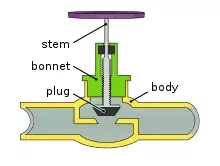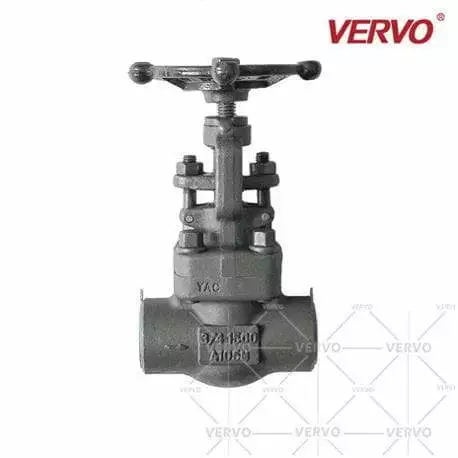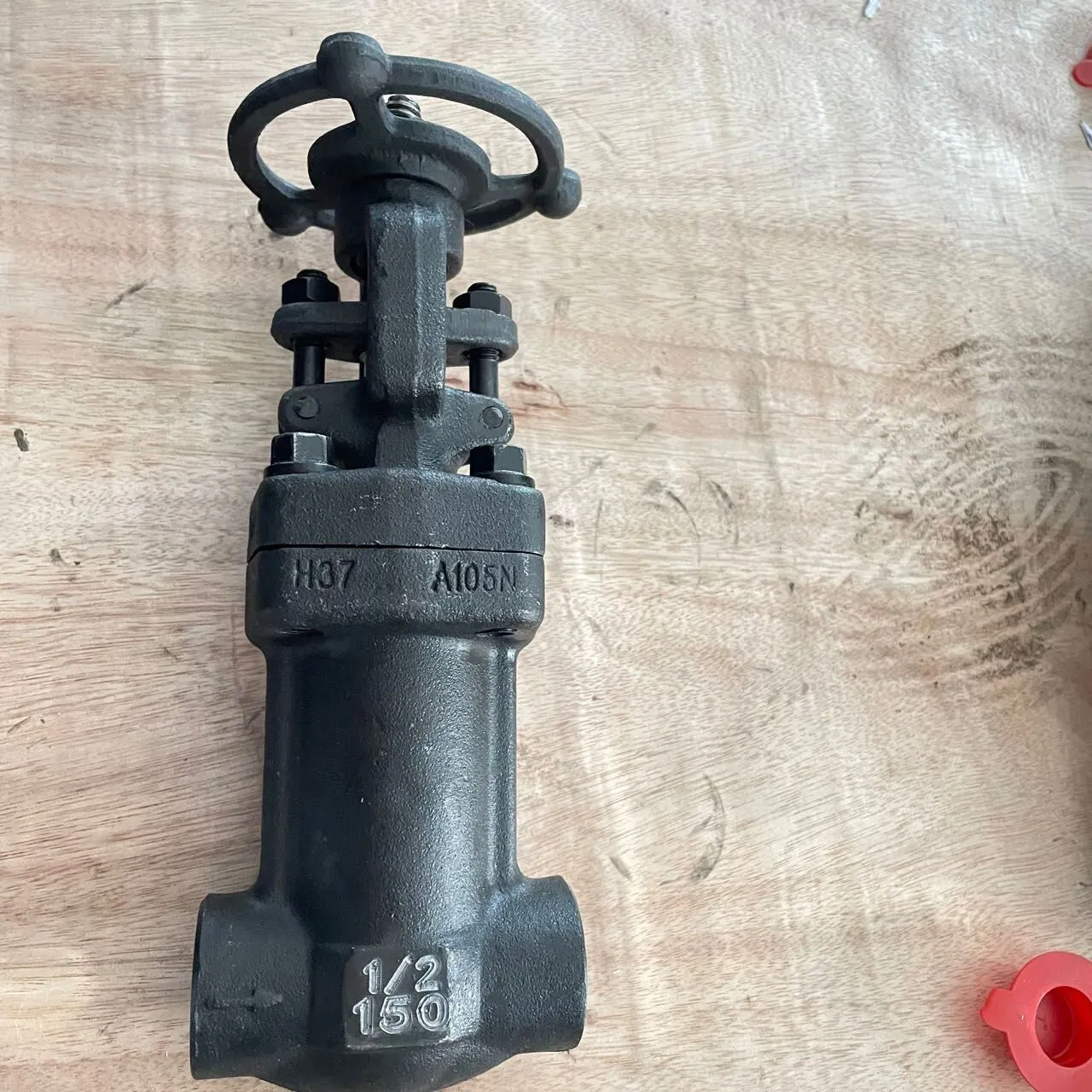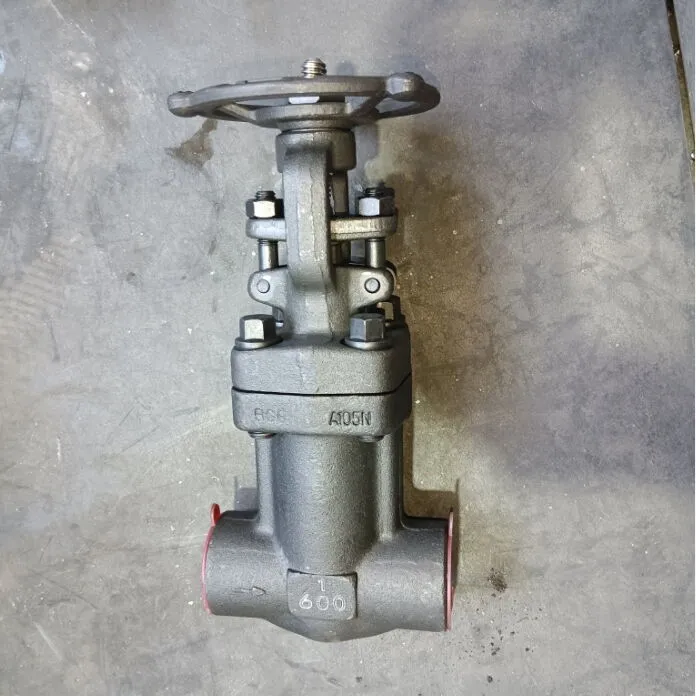Globe Valves
What is a globe valve?
The stem axis of the globe valve is perpendicular to the sealing surface of the valve seat. The opening or closing stroke of the valve stem is relatively short, and it has a very reliable shut-off action, which makes this kind of valve very suitable for cutting off, regulating and throttling the medium. Once the disc of the globe valve is in the open state, the contact between its seats and sealing surfaces of the disc is no longer in contact, and it has a very reliable function of cutting off.

The working principle of globe valves

The working principle of globe valves
The valve stem of the globe valve is generally rotated and lifted, and the handwheel is fixed on the top of the valve stem. When the handwheel is rotated clockwise, the thread of the valve stem moves down, and the sealing surface of the valve disc is in close contact with that of the valve seat; the globe valve is in a closed state; when the handwheel is rotated counterclockwise, the thread of the valve stem moves up; the sealing surface of the valve disc is separated from that of the valve seat, and the globe valve is opened. Once the globe valve is in the open state, there is no longer any contact between its seat and the sealing surface of the disc, so the mechanical wear of its sealing surface is small. The seat and disc of most globe valves are relatively easy to repair or replace. It is not necessary to disassemble the whole valve from the pipeline, which is very suitable for the occasion when the valve and pipeline are welded into one. The flow direction of the medium changes when passing through this type of valve, so the flow resistance of the globe valve is higher than that of other valves.
Applications of glove valves
This kind of valve is very suitable for cutting or regulating and throttling the medium. It is one of the most widely used valves. The reason is that the friction between the sealing surfaces is small in the opening and closing process; the globe valve is durable and easy to manufacture, which is suitable for low, medium pressure and high pressure.


Advantages of globe valves
a. Compared with the gate valve, the globe valve has a simple structure. Usually, there is only one sealing surface on the valve body and the valve disc. The sealing area is small; precious materials are saved, and the cost is low. Therefore, the manufacturing process is good and it is easy to maintain.
b. The sealing surface is less worn and scratched, and the sealing performance is good. When the valve is opened and closed, there is no relative sliding between the valve disc and the sealing surface of the valve body (except the conical sealing surface), so the wear and abrasion are not serious; the sealing is good, and the service life is long.
c. The opening height is small, generally only 1/4 of the diameter of the valve seat channel; the structure is compact, and the installation space is saved.
b. The sealing surface is less worn and scratched, and the sealing performance is good. When the valve is opened and closed, there is no relative sliding between the valve disc and the sealing surface of the valve body (except the conical sealing surface), so the wear and abrasion are not serious; the sealing is good, and the service life is long.
c. The opening height is small, generally only 1/4 of the diameter of the valve seat channel; the structure is compact, and the installation space is saved.
Total 179 Records
ASTM A182 F22 Globe Valves, API 602, 1500 LB, 2 Inch, BW
Category: Globe Valves
Model no.VERVO-GLV-20241227-08
Request a quote
High Temperature Globe Valve, A182 F22, 800 LB, 2-1/2 Inch
Category: Globe Valves
Model no.VERVO-GLV-20241227-07
Request a quote
Carbon Steel ASTM A350 LF2 Globe Valve, ISO 15761, PN63, DN20
Category: Globe Valves
Model no.VERVO-GLV-20241227-06
Request a quote
ASTM A182 F304 Globe Valve, API 602, 150 LB, 1 Inch, OS&Y
Category: Globe Valves
Model no.VERVO-GLV-20241227-05
Request a quote
ASTM A105N Bellows Globe Valve, 600 LB, 1 Inch, API 602, BB
Category: Globe Valves
Model no.VERVO-GLV-20241227-04
Request a quote
API 602 Globe Valve, ASTM A105N, 1/2 Inch, 150 LB, OS&Y
Category: Globe Valves
Model no.VERVO-GLV-20241227-03
Request a quote
API 602 Stainless Steel Globe Valve, A182 F304,1/2 IN,150 LB
Category: Globe Valves
Model no.VERVO-GLV-20241227-02
Request a quote
BS 5352 Carbon Steel Globe Valves, DN25, PN16, ASTM A105N
Category: Globe Valves
Model no.VERVO-GLV-20241227-01
Request a quote
API 602 Bellow Sealed Globe Valves, 150 LB, 1/2 Inch, A105N
Category: Globe Valves
Model no.GV-20241123-05
Request a quote
ASTM A105N Globe Valve, API 602, CL 600 LB, 3/4 Inch, BB, SW
Category: Globe Valves
Model no.GV-20241123-04
Request a quote
Carbon Steel Bellow Globe Valve, ASTM A105N, 1 IN, 600 LB
Category: Globe Valves
Model no.GV-20241123-03
Request a quote
ASTM A182 F304 Bellow Seal Globe Valve, API 602, 2IN, CL600
Category: Globe Valves
Model no.GV-20241123-02
Request a quote
Globe valves classified by bonnets
Bolted bonnet globe valves
The valve body and the bonnet are connected by bolts and nuts and sealed by the spiral wound gasket made of flexible graphite. Forged bolted bonnet globe valves are used on pipelines with various working conditions such as petroleum, chemical, pharmaceutical, fertilizer and power industries to cut off or connect the medium.
Welded bonnet globe valves
Welded bonnet globe valves are connected to the pipeline by welding. The sealing surface of the welded bonnet globe valve is not easy to wear and scratch. The welded bonnet globe valve has good sealing, long service life, compact structure, good opening and closing, small height, easy maintenance, high-temperature resistance and high-pressure resistance, which is applied to petroleum, chemical industry, electric power, metallurgy, pharmaceuticals, food, water treatment, municipal water supply and drainage, natural gas, papermaking, electronic industry, buildings, mechanical equipment and other fields.
| Sizes | DN15 to DN200 |
| Temperature ranges | -20℃ to 600℃ |
| Pressure | PN16 to PN320 |
| Materials of valve bodies | WCB, 304, 316, WC6, WC9 |
| Materials of valve stems | SS304, WC6, WC9 |
| Materials of valve bonnets | They have the same materials as the body. |
| Materials of valve seats | Stainless steel or alloy ammonia |
| Connections | Welding |
| Applications | Used for water, oil, steam, and some corrosive liquids |
Pressure seal bonnet globe valves
A pressure seal bonnet globe valve refers to a valve whose valve discs move along the centerline of the valve seat. According to this moving form of the valve disc, the change in the valve seat port is proportional to the stroke of the valve disc. The valve stem of this type of valve has a relatively short opening or closing stroke, and has a very reliable function of cutting off.
Pressure seal bonnet globe valves have elastic wedges and the valve stem has the function of upper sealing. The sealing surface is surfaced with CR13, cemented carbide, which is wear-resistant, high-temperature resistant and has a long service life.
Pressure seal bonnet globe valves have elastic wedges and the valve stem has the function of upper sealing. The sealing surface is surfaced with CR13, cemented carbide, which is wear-resistant, high-temperature resistant and has a long service life.
Globe valves classified by body design
Straight-through globe valves
The medium inlet and outlet passages of the straight-through globe valve are in the same direction, which is at an angle of 180. This type of globe valve reduces the degree of damage to the flow state, so the pressure loss through the valve is also reduced accordingly. It relies on the pressure of the valve stem to make the sealing surface of the valve disc and the valve seat well combined, preventing the medium from flowing.
In the opening and closing process, the friction between the sealing surfaces is small; the straight-through globe valve is wear-resistant, has a small opening height, and good manufacturing process performance. Compared with the gate valve, the structure of the globe valve is simpler, and the manufacture and maintenance are convenient.
In the opening and closing process, the friction between the sealing surfaces is small; the straight-through globe valve is wear-resistant, has a small opening height, and good manufacturing process performance. Compared with the gate valve, the structure of the globe valve is simpler, and the manufacture and maintenance are convenient.
Y globe valves
To change the straight-through tortuous fluid channel, the valve seat hole and the valve body are designed at a certain angle, so that the flow channel becomes more straight with the axis to reduce the pressure loss. Y globe valves are used for steam systems. Y globe valves make the fluid hardly change its flow direction, which has the smallest flow resistance. The valve seat and valve disc’s sealing surface can be surfaced with cemented carbide, which makes the whole valve more resistant to scouring and corrosion, is very suitable for pipeline control in the alumina production process, and also suitable for pipelines with coking and solid particles. Y globe valves are usually made by casting, and the high-pressure valve is formed by forging. According to different working conditions, special materials such as duplex stainless steel can be selected.
Angle globe valves
Looking back on the development history of globe valves, the angle-type globe valve was initially developed, and then straight-through globe valves were gradually developed. Angle globe valves have the unique advantage of being installed at the corner of the pipeline system, which not only saves the 90° elbow, but also facilitates the operation. Therefore, these valves are most suitable for ammonia production systems in fertilizer plants and refrigeration systems.
The common size and pressure of angle globe valves are usually DN50 to 250 (NPS 2 to 10), Class 150 to 800. Small copper alloy threaded angle globe valves are widely used in clean water. Most industrial angle globe valves are bolted bonnet globe valves made from cast steel, bronze, stainless steel and duplex steel.
The common size and pressure of angle globe valves are usually DN50 to 250 (NPS 2 to 10), Class 150 to 800. Small copper alloy threaded angle globe valves are widely used in clean water. Most industrial angle globe valves are bolted bonnet globe valves made from cast steel, bronze, stainless steel and duplex steel.
Plunger globe valves
This type of plunger valve has radial sealing, which is realized by two elastic sealing rings sleeved on the polished plunger. The two elastic sealing rings are separated by a lantern ring, and the elastic sealing ring around the plunger is pressed firmly by the load applied to the valve bonnet through the connecting bolt of the valve body and the valve bonnet to ensure the sealing. The shell is made from carbon steel, plunger stainless steel, and sealing ring flexible graphite. If the shell is made from stainless acid-resistant steel, the plunger is made from stainless acid-resistant steel, sealing ring PTFE, which makes the plunger globe valve suitable for acid and alkali corrosive media. This valve has the advantages of reliable sealing, long service life and easy maintenance and the disadvantage of slow opening and closing speeds. This type of valve is widely used in urban construction systems, water and steam pipelines in urban heating.
Tee globe valves
The tee globe valve is usually used in high-pressure systems as a reversing valve, for example, high-temperature and high-pressure water feeding valves for the power station boiler. Reversing valves are usually used for startup, shutdown or failure. The tee globe valve body is generally made from cast steel or alloy steel. Tee globe valves used in power plants generally use butt welding to overcome the problem of leakages due to flanged ends.


Globe valves classified by uses
Needle globe valves
A needle globe valve is used for precise flow control. The valve disc is usually integrated with the valve stem, and it has a very high-precision needle head matched with the valve seat. Moreover, the thread pitch of the stem thread of the needle globe valve is thinner than that of the ordinary globe valve. In general, the size of the needle globe valve seat hole is smaller than the pipe size. Therefore, it is only used in pipelines with small nominal diameters.
High-temperature and high-pressure power station globe valves
The connection between the valve body and the bonnet of the high-temperature and high-pressure power station globe valve adopts pressure self-tightening sealing or clamping. The connection between the valve body and the pipeline is butt welding, and the valve body is mostly made from chrome molybdenum steel or chrome molybdenum vanadium. The sealing surface is mostly surfacing hard alloys. Therefore, this kind of valve is resistant to high temperature and high pressure, and has good heat resistance; the sealing surface is resistant to wear, abrasion, corrosion, and has good sealing performance and long service life. It is most suitable for pipelines with high temperature and high pressure, steam, petroleum products and superheated steam in thermal power industrial systems, petrochemical systems and metallurgy.
Fluorine-lined globe valves
The opening and closing part of the fluorine-lined globe valve is a plug-shaped valve disc, and a sealing surface is a plane or a conical surface; the valve disc moves linearly along the center line of the fluid. The movement of the valve stem includes lifting stems and lifting rotating stems. The valve stem of lifting stems rises and falls, but the handwheel does not rise and fall. The handwheel of lifting rotating stems rotates and lifts together with the valve stem, and the nut is arranged on the valve body. Fluorine-lined globe valves are suitable for aqua regia, sulfuric acid, hydrochloric acid, hydrofluoric acid and various organic acids, strong acids and strong oxidants with various concentrations at a temperature of -50℃, and can also be applied to the pipeline with strong alkali organic solvents with various concentrations, corrosive gases and liquids.
Insulation globe valves
Insulation globe valves are mainly used in petroleum, chemical, metallurgy, pharmaceutical and other systems to transport high-viscosity medium that will solidify at room temperatures. The side and bottom of the insulation globe valve are provided with two connection ports for the thermal insulation jacket. Insulation globe valves are widely used in various systems such as petroleum, chemical, metallurgy, and pharmaceutical systems.
API globe valves
The connection between the valve body and the bonnet, the installation of the stuffing box, the valve stem nut, and the upper seal of API globe valves should be all designed in strict accordance with the API design. The selection of materials, testing of valves should be carried out based on the requirements. API globe valves are widely used in petrochemical pipelines, electric power, metallurgy, textile and other systems.
Globe valves for oxygen pipelines
Oxygen pipeline globe valves should be strictly designed according to the requirements of the oxygen pipeline. The stuffing box should be well sealed, and external dirt must not enter the stuffing box. The flanges at both ends of the valve body have grounding devices. After installation on the pipeline, they should be grounded to prevent static electricity and igniting. The valve shell is made from austenitic stainless steel or copper, which has good electrical conductivity and is not prone to static ignition. The sealing is PTFE, which is a soft seal, with good sealing performance and zero leakage for the gas. The valve is strictly degreased by carbon tetrachloride before assembly, and there is absolutely no grease and dirt, which will not cause a static fire. The valve is suitable for oxygen pipelines in metallurgical systems, and oxygen pipelines in other industries.
Bellows globe valves
Bellows globe valves are also called bellows seal globe valves. Through automatic rolling welding, a metal barrier is formed between the fluid and the atmosphere to ensure zero leakage of the valve stem. The bellows globe valve adopts a bellows structure inside, and the lower end of the stainless steel bellows is welded to the valve stem to prevent the process fluid from eroding the valve stem. The other end is placed between the valve body and the valve bonnet to form a static seal. The double sealing will avoid leakages of the valve stem packing if the bellows fails. The bellows is welded to the valve stem to maintain stable operation and avoid vibration of the valve stem caused by the vibration of the valve plug. Bellows globe valves are most suitable for pipelines with steam, flammable, explosive, heat transfer oil, high purity, toxic and other media.
Forged steel globe valves
Forged steel globe valves are designed according to the standards of the American Petroleum Institute. The valve body and bonnet are made from carbon steel or stainless steel by forging. The valve body and bonnet are connected by bolts, threaded connections and welding, and there are upper threaded stems and lower threaded stems. The sealing pair is made from steel, stainless steel acid steel to STL hard alloy and the packing flexible graphite or PTFE. The valve can be connected by flanges, threads, socket welding and butt welding. The forged globe valve is widely used in the equipment and pipelines of petrochemical, electric power, chemical and other departments. The working media is steam, petroleum products and corrosive media.
Petroleum liquefied gas globe valves
This valve is specially designed for pipelines or equipment for petroleum-liquefied gas. The requirement of fire protection is paid attention to. The packing is made from polytetrafluoroethylene, which has reliable sealing and no leakage. The sealing pair is made from polytetrafluoroethylene or nylon, which is a soft seal with reliable sealing. Petroleum liquefied gas globe valves are suitable for liquefied petroleum gas pipeline systems as an opening and closing device, and also suitable for other pipelines whose temperature is less than or equal to 80℃.
Cryogenic globe valves
The cryogenic globe valve usually refers to the valve whose working temperature is lower than
-110℃, which is widely used in liquefied natural gas, liquefied petroleum gas and other low-temperature industries. Valve discs of cryogenic globe valves move along the centerline of the valve seat. According to this movement of the valve disc, the change of the valve seat port is proportional to the valve disc stroke. Cryogenic globe valves have a relatively short opening or closing stroke, and a function of very reliable cutting off, which makes them very good for regulating fluids.
-110℃, which is widely used in liquefied natural gas, liquefied petroleum gas and other low-temperature industries. Valve discs of cryogenic globe valves move along the centerline of the valve seat. According to this movement of the valve disc, the change of the valve seat port is proportional to the valve disc stroke. Cryogenic globe valves have a relatively short opening or closing stroke, and a function of very reliable cutting off, which makes them very good for regulating fluids.
Anti-scour globe valves
The anti-scour stop valve is suitable for water and steam pipelines as an opening and closing device. It is often applied to drainage for steam turbines, feed water, heaters, boiler drainage and superheaters. To avoid high-speed scouring of the medium, the valve adopts a reverse flow, and the valve sealing pair adopts the first throttling to block the dirt, and then uses the throttled medium to make the sealing surface clean by itself, thus completely solving the internal leakage.
Globe valves classified by positions of threads
Top threaded stem globe valves
Top threaded stem globe valves are globe valves whose stem threads are on the outside of the valve body. The advantage is that the valve stem is not eroded by the medium and is easy to lubricate. This structure is relatively common.
Lower threaded stem globe valves
Lower threaded stem globe valves are globe valves whose stem threads are on the inside of the valve. The stem thread is in direct contact with the medium, which is easily corroded and cannot be lubricated. This structure is used in places with small diameters and low temperatures. The nominal diameter of lower threaded stem globe valves is relatively small, and most of them are used in instrument valves and sampling valves.











